Overview of Russian light ships development
As in many other navies, Russia started the development of torpedo-boats as a sub-echelon, a type of ship which went after gunboats. The first Russian torpedo-boat was built at Baltic Works as eary as 1877. In the 1880s series of two to six ships from various yards, but also Schichau, Normand were intended to test the best design solutions. The first large homogeneous class was the Polangens, from 1894 (black sea fleet), followed in the French way by numbered series until 1903.
The very last one was a Yarrow boat. Since TBs lacked range and defensive capabilities to operate with the fleet, Russia also adopted the concept of torpedo-gunboats. The first one, Leitnant Ilin (1886) was followed by Capt. Saken, the Kazarski class, and Abrek (1896). It was at that time that the admiralty wanted ways to deal with TBs and ordered her first destroyer, in UK.
Russian destroyers lineage
From 200 to 500 tonners
The first Russian destroyer was launched in about the same time of comparable ships in the Spanish, British or French Navy, it was the Sokol (launched 1895), a Yarrow boat for testing purposes. It was very much a British destroyer, four-funnelled design. It was followed by large homogeneous series, the Puilki, and Boiki classes, and one-off variations for comparisons, the Boevoi (Laird, UK), and Bezstrashni class (Schichau) and Lt. Burakov, Vnimatelni class (Normand), local Tverdi class (Like Boiki), Lovki (Various French yards), Bditelni (Schichau), Storozhevoi classes (local).
These were all “300-tonners” better suited for coastal sorties. Then by 1904, the admiralty wanted larger fleet destroyers, 500 tonners, like the Ukrainia, Emir Bukharski, Gaidadamak, Okhotnik and Lt. Shestakov classes, all made in small series in local yards in the span of two years.
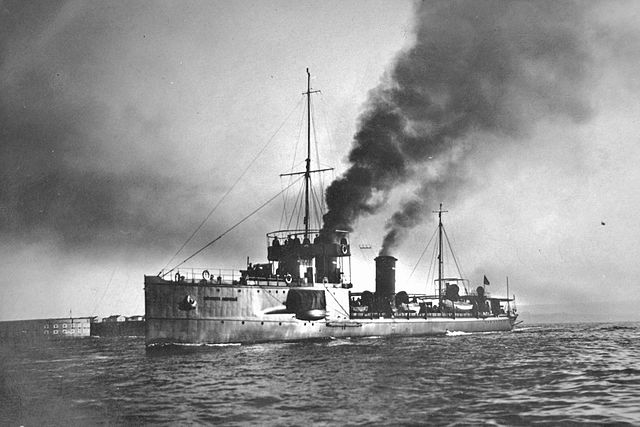
Towards a 1300 tons fleet destroyer
And then there was a pause. The admiralty was planning a true fleet destroyer, capable of long range and great spead to create a “screen” capable of taking the role of scout cruisers as well. This kind of design was very much in the air at that time. In 1907, the Royal Navy indeed unveiled the HMS Swift, a massive 2,000 tons “super-destroyer” which was Admiral’s own “Jackie” Fisher superfast pet project, mid-range between a cruiser and a destroyer.
The ship later revealed itself as an unmitigated disaster, but the Russian admiralty was nevertheless impressed by the concept, and commissionned a new design in 1908. Development went on in 1909 and the next year blueprints were accepted for the Novik.
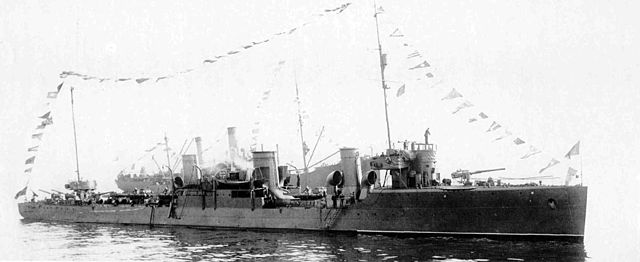
This was the first of a serie of 1300 tons, very large, very fast and well armed fleet destroyers. By 1911 the most powerful destroyer in service by a safe margin. For a tonnage less than the Swift, and less raw power, the Russian destroyer packed a far more deadly punch, with no less than four 102 mm guns and four twin torpedo tubes banks plus mines.
Power was obtained by German-built AEG turbines coupled with Vulkan boilers, for a total of 40,000 hp and 36 knots. There was nothing on the seven seas then to compare. The Novik was followed by several classes before and during WW1, some completed during or after he civil war, and the design was still relevant in 1941, many indeed seeing service all through WW2.

She was captured by the “reds” and served in the Baltic. She was transferred to the Soviet Pacific fleet via the Arctic in 1936, and was eventually broken up 1953, a good career for 1910s ships !
Russian destroyers before the Russo-Japanese war (1895-1905)
Pruitki (Sokol) the funder (1895)
Pruitki was a Russian destroyer ordered to Yarrow, to test the concept and make copies in local shipyards.

conway’s Pruitki profile 1/700
Puilki class: Large scale production boats (1896)
The four Crichton, Okhta, boats went to the Black Sea on completion. Ryeshitelni, Razyashchi, Rastoropni and the nine ‘S’ Nevski boats were sent to the Pacific in sections and assembled at Port Arthur. In general this class resembled Pruitki though all 13 Nevski boats had straight stems. Puilki, Poslushni, Prochni, Porazhayushchi, Pronzitelni, Ryeshizelni and Podvizhm had 8 boilers and the others 4 larger ones. None was as fast as Pruitki though Podvizhm is credited with 29kts. The vessels assembled at Port Arthur all took part in the Russo-Japanese War.
Silm’ was scuttled there on 2.1.1905, and was raised by the Japanese and served as the IJN Umizuki, while Ryeshitelni, captured at Chefoo on 12.8.1904, became the IJN Yamabiko.
The four surviving destroyers Serdiy, Smyeli, Skori and Statni were based at Vladivostock in the First World War. Of the Black Sea units, Strogi and Svimzepi were renamed Badina and Leitenant Schmidt after the Revolution. Puilki and Pronzitelni were transferred to the Caspian in 1907, and the remaining eight served as minesweepers in the Baltic during the First- World War. Ryani, Prozorlivi, Rygzmi, Poslushni, and Ponzyzhmi were taken over by the Finnish in 1918 and became SI to SS.
Specs Pruitki 1904 |
|
| Displacement: 220 t standardn 240 t FL. | |
| Dimensions: 57,91 x 5,64 x 2,3 m. | |
| Propulsion: 2 propellers, 2 VTE, 4 Yarrow boilers, 3800 hp 27.5 knots. | |
| Armour: None. | |
| Crew: 58. | |
| Armament: 1 x 76 mm, 3 x 47 mm, 2 TT 16 in (381 mm) | |
Boevoi (1898)

A four-funnel destroyer of the usual Laird type, with the ll-pdr forward and two single deck TT abaft the second and fourth funnel. Boevoi was torpedoed by a Japanese picket boat on 24.7.1904 but managed to make it to Port Arthur.
Bezstrashni class (1899)
Two-funnel, two-masted destroyer with the ll-pdr forward and three deck TT for which 6 torpedoes were carried. The TT were on the centerline with two between the funnels and one abaft them. In the Russo Japanese war, Bditelni was scuttled at Port Arthur and the other three interned at Kiao Chau after the battle of 10.8.1904. In the First World War they were based at Vladivostok and in the White Sea. No known photo.
Leitenant Burakov (1898)
Originally the Chinese Hai Hoha captured by the British destroyers Fame and Whiting in the attack on the Taku forts, and assigned to Russia. She had two large funnels and two deck TT and was easily the fastest of the Russian flotilla in the war with Japan. She was torpedoed by the picket boats of the Mikasa and Fuji in Ta Ho Bay to the east of Port Arthur.
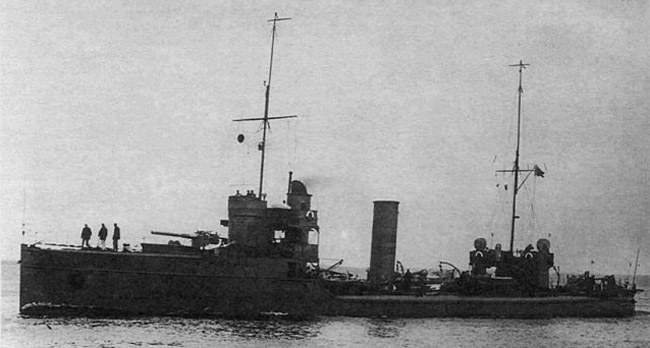
Ussurietz in 1905
Vnimatelni class (1900)
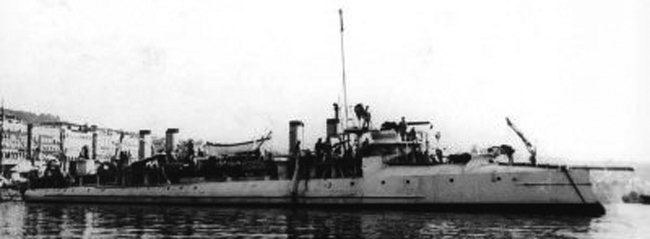
Resembled the French Durandal class but with two groups of two funnels. The ll-pdr was on the conning tower roof forward with a deck TT abaft each funnel group. In the Russo-Japanese War Vnushitelni was sunk by the Japanese fleet and Vunoslivi mined. Grozovoi, interned at Shanghai after the battle of 10.8.1904, and Vlastni, at Chefoo after the fall of Port Arthur, served at Vladivostok and then in the White Sea during the First World War, and then were taken over by Britain in 1918.
Boiki class (1901)
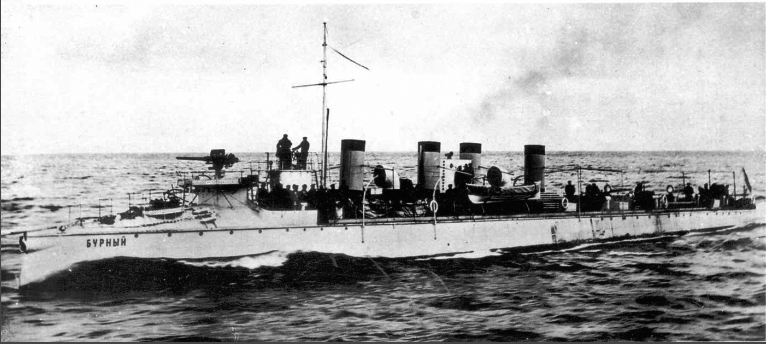
Zadorni later named Leitenant Pushchin. The five Belgian Works’ destroyers (at Nicolaiev) and the four Nicolaiev were Black Sea Fleet boats. These were Yarrow-type, four-funnel destroyers resembling an enlarged Pruitki.
There were two single deck TT and one in the stem which was later removed, and 6 torpedoes were carried. Only the 5 built by Belgian Works had Normand boilers. In the Russo-Japanese War Boiki and Burmi were at Port Arthur, the former escaping at the surrender while Buini, Bravi, Blestyashtchi, Buistri, Bodri, Byedovi, Bezuprechmi, Gromki and Grozni fought at Tsushima.
Byedovi with the seriously wounded Admiral Rozhestvenski on board, was captured by the Japanese and served as the Satsuki. Boiki, Brami, Bodri and Grozmi were at Vladivostock during the First World War and Vidni and Gromyaschi in the Baltic. Zhivoi was lost in the Sea of Azov, when part of Wrangel’s fleet. Bravi, Zavidni and Grozni were renamed Anisimov, Marti and Balyank after the revolution.
Lovki class (1905)
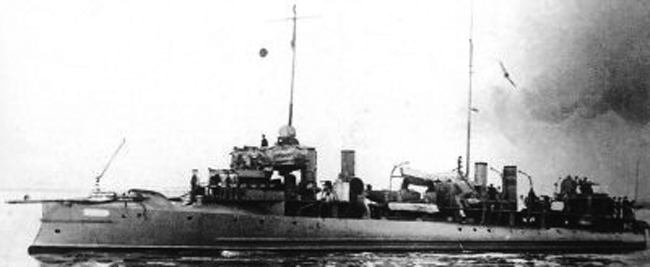
Letuchi of the Lovki class
Eleven 400 tonnes French-type destroyers with four funnels in two groups abaft the fore and mainmasts. The ll-pdr guns were on the roof of the forward and after conning towers and the two single deck TT abaft the groups of funnels. All served in the Baltic during the First World War in which Spolnitelni was lost by the explosion of one of her own mines on the same occasion as Letuchi which capsized in a violent snow storm. Burakov was mined when acting as a despatch vessel.
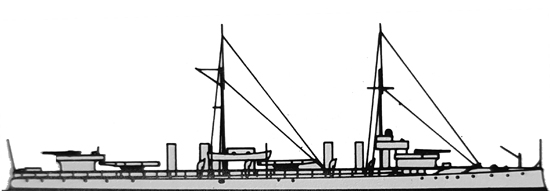
conway’s Lovki profile 1/700
Specs Lovki 1904 |
|
| Displacement: 402 t standardn 420 t FL. | |
| Dimensions: 56,60 x 6,40 x 3,40 m. | |
| Propulsion: 2 propellers, 2 VTE engines, 4 Normand boilers, 5700 hp 27 knots. | |
| Armour: None. | |
| Crew: 67. | |
| Armament: 2 x 76 mm, 2 TT 18 in (457 mm) | |
Bditelni class (1905)
Ten 355 tonnes Ram-bowed destroyers with a short forecastle and two widely spaced funnels. The ll-pdrs were on the forecastle-deck forward and upper deck aft and the three single deck TT on the centreline, two being between the funnels and one between the after funnel and mainmast.
Vuinoslivi appears to have been the fastest of the class with 28.72kts on trials. During the First World War Yurasovski and Sergyeev served at Vladivostock and later in the White Sea, while the rest were in the Baltic where Bditelni was lost on a mine.
After the Revolution Dmitriev, Zvyerevi, Vnushitelmi and Vuinoslivi were named Roshal, Zhemchuzhny, Martinov, and Artemev, being latterly employed as training ships, as according to some accounts was Vnimatelni under the name of Osoaviakhim.

conway’s Bditelni profile 1/700
Storozhevoi class (1905)
Similar to the Boiki class and of Yarrow-type with four funnels. The ll-pdrs were mounted on the roof of the fore conning tower and right aft, with the two single deck TT fore and aft of the after conning tower. All served in the, Baltic, in the First World War, when Stroini grounded in the Gulf of Riga and was so badly damaged by a 1301b bomb from a large German seaplane that salvage was abandoned. Some were transferred to the Volga or Caspian sea during the civil war.
Ukraina class (1904)
This class comprised the first of the larger Russian destroyers and the ships were of distinctive appearance With a ram bow, high forecastle, rounded stern and three funnels, The ll-pdr were forward and aft with the 6pdr on each beam, a single deck TT between the second and third funnel, and a twin deck TT mounting abaft the mainmast. Originally they were reported as lacking in stability.
The armament was altered to 2-4in/60, mounted fore and aft and 2 single deck TT fore and aft of the third funnel, the mainmast being replaced further aft. During the First World War, in which they served in the Baltic, Kazanetz being lost on a mine, the gun armament was again altered to 3-4in/60 all aft, with a 4omm AA on the forecast Aft. After the revolution Ukraina, Voiskovoi and Turkhmenetz were renamed Barinski, Rabochi, Maekin, and altvater, stationed in the Caspian as gunboats.

Conway’s Ukraina profile 1/700
Specs Ukraina 1904 |
|
| Displacement: 580 t standard, 640 t FL. | |
| Dimensions: 73,15 x 7,16 x 2,30 m. | |
| Propulsion: 2 propellers, 2 VTE engines, 4 Normand boilers, 7000 hp 26 knots. | |
| Armour: None. | |
| Crew: 90. | |
| Armament: 3 x 102 mm, 1x 40mm Bofors AA, 3 TT 18 in (457 mm) | |
Emir Bukharski class (1905)
Built to drawings prepared by Schichau, who also supplied the machinery, these ships resembled an enlarged Bditelni class. The ll-pdr were fore and aft with the 6pdr on either beam and three single centreline deck TT, two between the funnels and one abaft the after funnel. Shortly before the First World War, these guns were replaced by 2-4in/60, and during the war, in which they served in the Baltic, one 37mm AA was added.
There was also provision for 20 mines. Dobrovoletz was lost on a Russian mine and Moskmtyanin was sunk by 6-in and 4-in gunfire of the improvised British “Caspian squadron” in the action at Alexandrovsk. Emir Bukharski and Finn were renamed Yacob Sverdlov and Karl Liebknecht after the Revolution and were employed in the Caspian.

Conway’s Emir Bukharski class profile
Gaidamak class (1905)
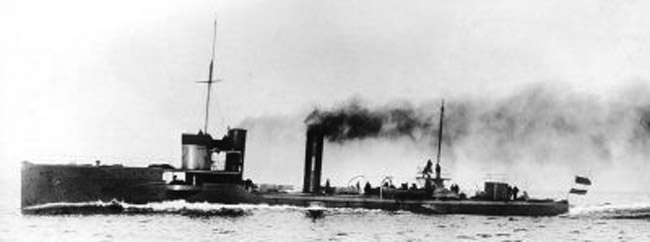
Two-funnel destroyers with a high forecastle and straight stem. Material for Amuretz and Ussurietz was supplied by Krupp, Germania. The 11-pdr were fore and aft, with four of the 6pdrs on either beam and two in sponsons below the bridge, the forecastle being recessed to allow ahead fire.
The TT bank was in single deck mountings on the centreline, between the funnels, abaft the second funnel, and abaft the mainmast. Shortly before the First World War, they were rearmed with 2-4in/6O and the sponsons and forecastle recess removed All were in the Baltic during the war and had l-37mm AA added, while 25 mines could be carried. After the Revolution Vsadnik, Amuretz and Ussurietz were renamed Sladkov, Zhelesniakov, and Roshal, used as gunboats or training ships.
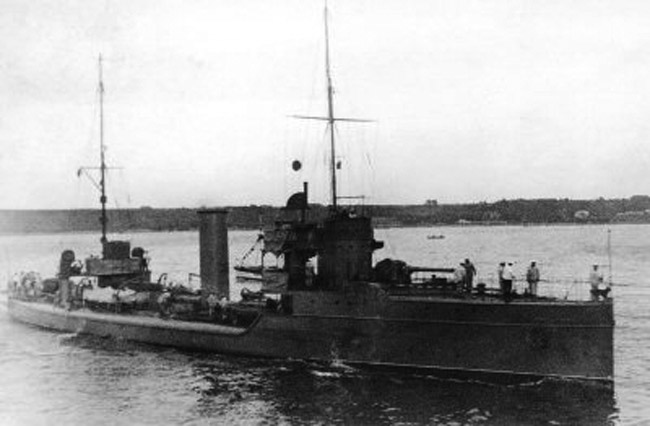
Vsadnik of the Gaidamak class

Conway’s Gaidamak class profile
Okhotnik class (1905)
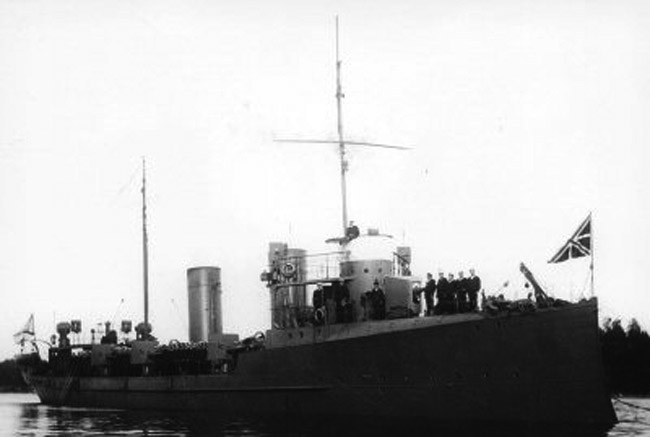
General Kondratenko of the Okhotnik class
Resembled a two funnel version of the Ukraina class in appearance. The ll-pdr were fore and aft, the 6-pdr on either beam and the three single deck TT between the funnels, abaft the second funnel and abaft the mainmast, all on the centreline. It should be noted that photographs distinctly show the above armament, though some accounts credit them with 2-4.7in/30 instead of ll-pdr.
The original guns were replaced by 2-4in/6O mounted fore and aft, and during the First World War, in which they served in the Baltic, this was increased to 3-4in/6O by adding another gun aft. There was also two 3pdr AA, and 40 mines were carried when used as minelayers, the four destroyers forming a special half-flotilla. Okhotnik was sunk by a German mine. Sibirski Stryelok was renamed Konstruktor after the Revolution and was later used as leader of mine-sweepers, and finally as a gunboat.

Conway’s Okhotnik class profile
Leitenant Shestakov class (1905)
Black Sea Fleet boats, the Belgian Works being at Nicolaiev. Kapitan Saken was originally to be named Leitenant Pushchin. Resembled the Gaidamak class in appearance but differed in gun armament with the 4.7in forward, one ll-pdr aft, one each beam and one in each sponson below the bridge. These guns were later changed to 2-4.7in/30 mounted fore and after with 2-3pdr AA and provision for 40 mines. Leitenant Zazzarenni was sunk by a mine. This class is seldom mentioned in accounts of First World War Black Sea fighting, possibly because of their lack of speed as Saken the fastest, only did 24.8kts with 7130 ihp on trials.
Russian destroyers of WW1 (1911-1918)
In 1909 reflections about a new kind of fleet destroyer, which actions could have been decisive in 1905 but were also dictated by a new standard that was brewing in several admiralties and publications, like the HMS Swift. The idea was to completely break with the idea of an improved torpedo boat and go for a long-range, well armed and fast ship able to perform screening and reconnaissance missions.
Therefore the Russian admiralty took a bold step with a new kind of design that was introduced by the Novik (bearing the name of a cruiser). When she was commissioned on 9 September 1913, the Novik left everyone flat-footed. Longer than 100 meters, 1600 tonnes in displacement, using oil-firing boilers, capable of 37 knots which was unheard of at that time (most TBs could barely do 30 knots), and heavily armed, this new kind of destroyer triggered responses in nearly all countries now plunged into the war.
German expertise however in drawing the blueprints and creating the powerplant had some consequences, but the Russians were able to order about 52 more destroyers in four 100% locally designed groups from various yards in the same general lines. These groups were the Derzky (Bespokoiny)-class destroyer, Orfey-class (Leitnant Ilin), Izyaslav-class and Fidonisy-class (Kerch) destroyers.
Eventually many would never be completed, because of the revolution or after the civil war and later served with the Soviets, others were lost during the civil war, sometimes fighting on both sides. Most also saw action in WW2 since their core design was still relevant. The Germans however dragged feets before going into that kind of large destroyers that they perhaps saw as an overkill for conditions in the Baltic. The nearest they had were the small G101 group, originally intended for Argentina and requisitioned. Needless to say in the long run, each of these class would receive a dedicated post with operations in detail for each ship.
Novik, the revolution (1911)

Ordered on 11 August 1909 for 2 million roubles which remained the budget after 18 destroyers and 4 submarines had been ordered thanks to the funds earned by public subscription. The principal dimensions were decided at the end of 1905 and aimed at a 36kt, turbine-driven, oil-fired 1400 ton destroyer. This was a radical departure over previous design, a bold undertaking but fit for a true blue water navy that had global ambitions.
Design tenders were invited from Russian yards in 1908 and the contract was awarded to the Putilov Yd which supplied a design prepared with the help of the German Vulkan Yard from Stettin. The latter was also the subcontractor for the machinery plant and much of the fittings. The original design called for two 4in guns but this was augmented in 1912 as was done on the other 35kt designs.

This and other additions as well as weight miscalculations caused a displacement increase of 140 tons and increased the draught by 1 feet which was concealed by the yard simply by putting the draught marks up. Speed trials started on 30 May 1912 and showed 35.8kts. These were repeated twice after a change of propellers, but only peaked at 35.97kts. The Vulkan Yard unaware of the draught excess, and tried to improve the boiler output by lengthening the water tubes by August 1913. Novik then reached 37. knots in a short run but sustained 36.86kts for three hours, earning the world record of the fastest ship ever.
Novik was eventually commissioned with the Cruiser Brigade on 4 September 1913, and later became the flagship of the Destroyer Division in 1915. She was sent in drydock in 1918 to be converted to the 1717t standard flotilla leader but due to the change of regime, she was recommissioned as Yakov Sverdlov. This conversion was reversed in December 1940 and she was reverted as fleet destroyer. She made a new career in WW2, but this is studied in the WW2 Soviet destroyers section.
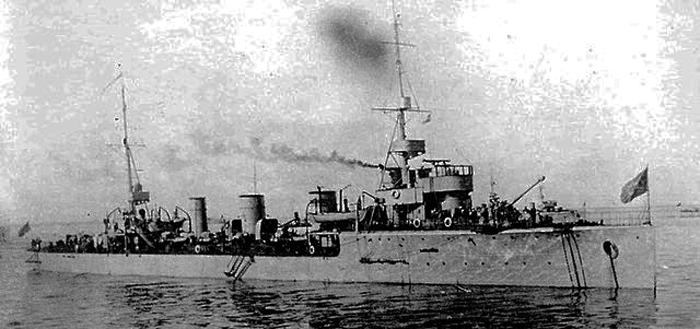
Yakov Sverdlov (former Novik) in the interwar
Bespokoiny class (1913)
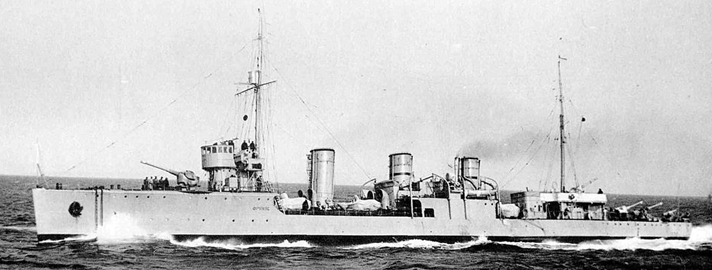
Also frequently called Derzki class. The first serie derived from the Novik comprised nine ships. These were part of the 1911 program intended for the Black Sea Fleet. Design Studies just after the issue of the 1907 Naval estimate and preliminary characteristics were strongly influenced by the Novik. Tenders were invited and the blueprints prepared by Metal Works was regarded as the best.
The contract was not signed yet however, since the new 1908 naval program ignored the building of new destroyers. The Naval General Staff changed the requ1rements by adding a single 4-in gun, six 18-in TTs and pressed for use of AEG or Parsons turbines, instead of the Rateau model preconized in the awarded design.

Tenders for the design were invited once again, displacement increased to 50 tons to house the additional armament, and that cost a knot of speed.
It was stipulated also that these ships had to be built by Black Sea Yards only. Putilov Yard, backed by Vulkan, and the Black sea Naval Admiralty Yard, backed by Vickers, were awarded design contracts. The latter became mandatory for the other Baltic coast yards which were to deal with the order. In the end there were design variations recognisable by the shape of the funnels: Round section at Putilov Yd, and the oval at the Naval Yd.
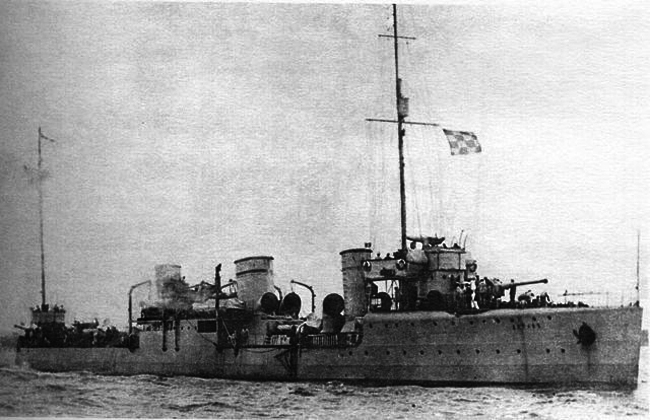
A small assembly yard was erected at Vadona, off Kherson, to lay down the hulls of Bystry, Pyliki and Schastlivy (sections were subcontracted to the Putilov Yd). The hulls of Gromki and Pospeshny were laid down in the Admiralty Yard, Nikolayev. Except for the Nevski Yard, the other Baltic coast yards subcontracted the turbines to Vulkan. Because of labour and transportation problems the Nevski and Putilov orders were taken over by the Naval Yard.
The first four destroyers were commissioned on 29 October 1914 while the Baltic boats entered service in summer 1915, a year behind Schedule. None achieved the contracted speed during trials. Bespokoiny was the best at 32.7kts, Pylki only reached 28.9kts. It was not precised if forced heat was used.
Wartime Career:
Derzki was damaged slightly during a duel with Turkish cruiser Hamidieh in January 1915, Pospeshnyi was badly damaged by German aircraft on 25 August 1916 during action against the U-boat base at Varna.
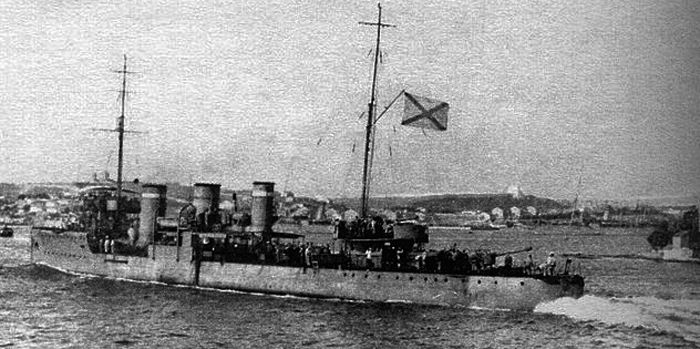
Except for Bystry and Schastlivy which raised the Ukrainian colors, the others left Sevastopol for Novorossisk on 30 April 1918 (and Gnevny was badly damaged by German shore batteries) but returned except for Pronzitelny and Gromkzi which were scuttled there.
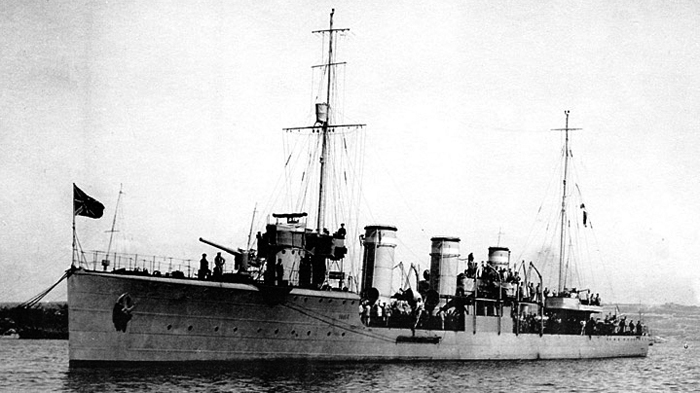
These destroyers were seized by the Germans who commissioned Schastlivy in October 1918 as R 01 while Bystry and Gnevny were designated R 02 and R 03. They never entered service however. They were Handed over to the Allies in November 1918. Byslry was scuttled by the British on 6 April 1919 to avoid capture by the Reds She was later refloated by the Soviets and recommissioned as Frunze on 2 December 1927. Schastlivy was stranded in a gale while under British tow to Malta. The other ships served with Wrangel’s fleet in September 1919. Bespokoiny was damaged by a mine on 15 September 1920 off Kerch while transiting to the Sea of Azov.

Specs Derzky 1915 |
|
| Displacement: 1100t standard – 1320t FL. | |
| Dimensions: 98 x 9,3 x 3,2 m. | |
| Propulsion: 2 propellers, 2 VTE engines, 5 boilers, 25,500 hp, 32 knots. | |
| Armour: None. | |
| Crew: 125. | |
| Armament: 3 x 102 mm, 2x 47 mm, 2x Maxim MGs, 5×2 TT 18 in (457 mm), 80 mines | |
Leitnant Ilin class (1915)
Part of the 1912 Programme, designated for the Baltic Fleet. The preliminary characteristics aimed at a modified Bespokoiny class with an armament of 2-4in/60, 12-18in TT (6X2). The existing Putilov Yd design for the Black Sea destroyer was duly changed and offered as the common enterprise by the Putilov Yd, Metal Wks and Russo-Baltic Yd. This was accepted by the Naval Staff after double TT sets were replaced by 4 triple ones to avoid a blast effect from the after 4in gun on the aftermost TT.
The orders were placed in December 1912 for 22 boats that were to be identical in appearance as the three yards decided to go on with the common working design. In August 1915 when some of the boats were fairly advanced the gun armament was enlarged by the Naval Staff simply by replacing one TT mounting with one (later 2) 4in/6O as a temporary measure to increase the firepower of the light forces until the S wetland class cruisers were completed.
The class was ordered in three groups, by yard, of 22 ships (14 completed), built at:
-Putilov Yd, Petrograd: Kapitan Belli (29.10.15), Kapitan Izylmetev (4.11.14), Kapitan Kern (27.8.15), Kapitan I Ranga Miklucha-Maklai (27.8.15), Leitenant Dubasov (9.9.16) and Leitenantn Ilin (28.11.14). BU incomplete 1923: Kapitan Konon-Zotoz, Kapitan Kroun.
-Metal Works, Petrograd: Orfej (5.6.15), Azard (5.6.16), Dema (4.11.15), Grom (5.6.15), Letun (4.11.15), Pobeditel (5.11.14), Samson (5.6.15), Zabijaka (5.11.14)
-Russo-Baltic Yd, Reval: Gavriil (5.1.15), Konstantin 12.6.15), Vladimir (18.8.15). BU Imcomplete: Mikhail, Mechislav, Sokol
These Russian destroyers were completed during 1915-17 and they formed the 1st, 2nd and 3rd Destroyer Flotillas (renumbered 11th, 12th and 13th later on) during most of the war. Kapitan Izylmetev served with the Active Squadron in 1919, and was renamed Lenin on 31 December 1922.
Kapitan I Ranga Miklucha-Maklai (renamed Spartak 18 December 1918) served with the Active Squadron and was captured off Reval by 2 British destroyers and 2 cruisers after running aground during an escape attempt on 26 December 1918, presented to Estonia in February 1919 and recommissioned as Wambola (see under Estonia). Leitenant Ilin served with the Active Squadron in 1919, being renamed Garibaldi on 3 July 1919, then Trotski 31 December 1922 and finally Voikov on 14 February 1928.
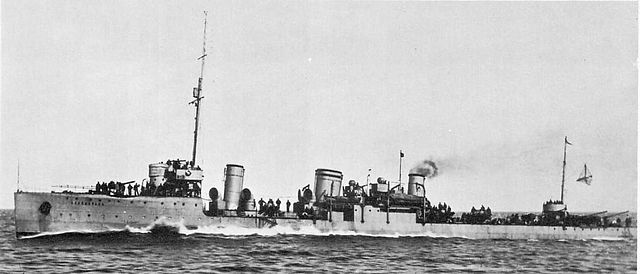
Russian destroyer Pobeditel
The destroyers ordered in the Metal Works were launched in the Izhora Yd, a branch of this enterprise established in 1912. The hulls of Pobeditel and Zabijaka had to be towed to Petrograd for completion while the others were fitted locally. Azard distinguished herself during sorties with the Active Squadron in 1919 encountering the British destroyer Walker (31 May) and helping sink the British submarine L55. In October 1919 she steered clear of a minefield where three of her sisters were lost and was renamed Zinoviev on 31 December 1922 and again Artem in 1934, participated in WW2.
Samson participated in the Bolshevik Revolution and together with Desna and Pobeditel was laid up in 1919. The three were renamed Stalin, Engels and Volodarski on 31 December 1922 and were reactivated by 1925. Letun and Orfei were damaged on mines (7 November 1916) and autumn 1917 respectively and laid up subsequently.
Zabijaka was damaged on a mine on 24 December 1915 off Dagerort during a Baltic minelaying operation but was z soon repaired and took part in the Bolshev1k Revolution. Laid up in 1919 and maimed Un’tski on 31 December 1922 she was reactivated 1n 1925. Gavn’il, Konstantin and Vladimir (renamed Svoboda on 12 September 1917) served with the Active Squadron in 1919.
The first one successfully escaped the British cruiser HMS Cleopatra when screening four escaped minesweepers on 17 May 1919 out from Kronstadt. On 2 June her gunners hit the pressure hull of the British submarine L 55 and she sank with all hands in Petrograd Bay after torpedoes had missed the destroyer. Once again she had luck being missed by a torpedo from CMB 24 and CMB 62 off Kronstadt, sinking her assailants a few minutes later. Svoboda was damaged by the British aircraft in Kronstadt. These three ships met a cruel end, being lost on a British mine.

Izyaslav class (1915)
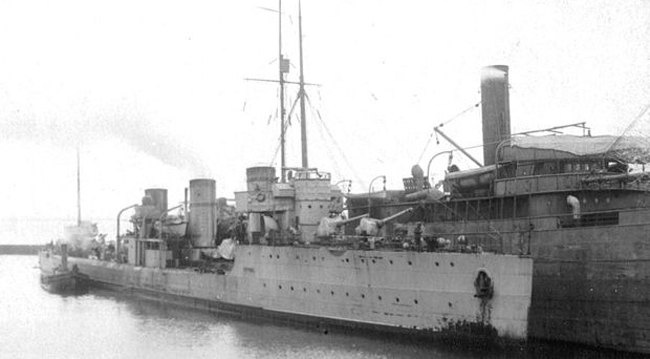
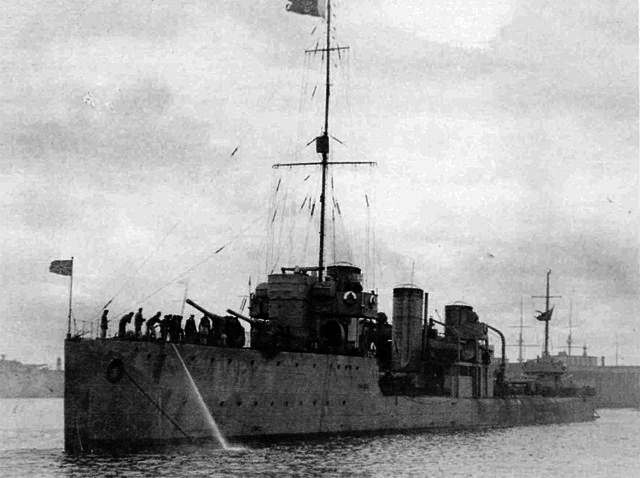

These Russian destroyers were included in the 1912 program for the Baltic Fleet. The design was prepared in collaboration with the French Normand Yard which also provided most of the fittings. Composition and distribution of armament underwent frequent changes. Originally it was to be to 4in/60, and twelve 18-in TT as contracted in 1913, but next year one triple TT bank was added, and in 1915 triple TT mounts were swapped for two additional 4-in guns, and later a fifth 4-in gun was added abaft the bridge.
The embargo set up by the Swiss Government after August 1914 meant that only Avtroil and Izyaslav ever received their designed turbines. New orders were placed for Pryamyslav, to be built in Britain and the remaining ones were to be made in the USA. Thus only the Avtroil, Izyaslav, and Pryamyslav were commissioned, launched in January, June and August 1915 at Böcker & Lange at Reval.
They served with the 3rd destroyer flotilla, which became the 13th. Because of the revolution, Izyaslav was laid up in 1918 and renamed Karl Marx, recommissioned in 1922. Avtroil was captured by British ships off Reval in December 1919 and was handed over to Estonia, and became Lennuk. The other incomplete ships were towed to Petrograd to avoid capture by the Germans in September 1917 and only Pryamyslav was completed in 1927 as Kalinin.
Gogland class (1916)
These Russian destroyers has been ordered under the 1912 program for the Baltic fleet in Schichau Yard in spite of growing tensions between nations, simply because that yard was able to offer a 25% lower bid than Russian yards. A new condition was raised that these ships should be assembled in Russia, so a Schichau subsidiary yard was founded in 1913 at Reval. The contract design provided planned two 4in/60, 12-18in TT, changed in 1915 to 6-18-in TT and a supplementary triple TT set was added later.
The hulls of Gogland, Grengamn, Patras and Strisuden were laid down in December 1913 but work practically stopped after August 1914. In June 1915 the yard was taken over by the Russian Government and Metal Works were ordered to complete these in 1918 as Fleet Minesweepers. They were to be armed with 5x4in/60, 1×40 mm AA, 6×18-in TT. The others were re-ordered to be completed on the Orfej class design. The former was only 18% ready in February 1917, canceled and latter scrapped, while the others were never laid down.
Kerch class (1916)
The class comprised the Fidomisi, Gadzhibei, Kaliakriya, Gadzhibei, Kaliaknya, Kerch, Korfu, Levkas, Tserigo, and Zante.
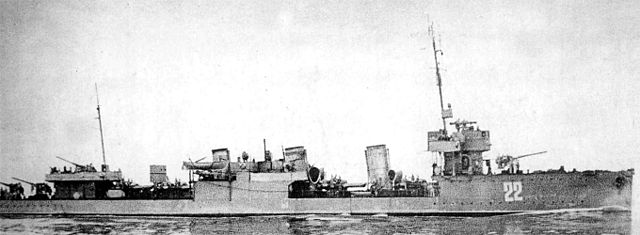
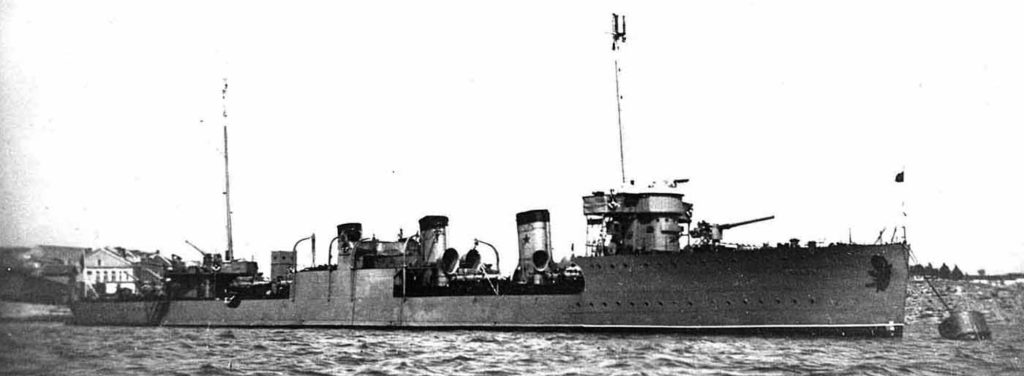
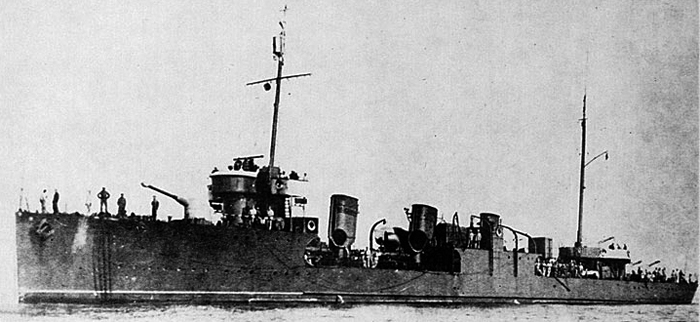
Russian destroyer Dzerzhinskiy
In the 1914 Programme for deployment with the Black Sea Fleet. This class was previously planned as an enlargement of the standard 35-knotter design 1500 tons displacement, armed with four 3in/60, one 47mm, two 40 mm AA, 2 MG, and twelve 18in TT (4X3). To keep costs as low as possible, an improved Bespokoiny class was finally decided on with one 4-in added.
Only four of them, namely FM, Gadzhibei, Kaliaknya and Kerch were completed by 1917 and formed the 3rd Destroyer Flotilla, but only the first of them saw any action. Influenced by the Bolsheviks, they left Sevastopol on 30 April 1918 and arrived at Novorossiysk where Gadzhibei was scuttled and Fidomsi sunk by a torpedo from Kerch. The latter, after sinking the battleship Svobodnaya Rossia was scuttled off Tuapse.
Tserigo was completed by the Whites in 1919 and commissioned with Wrangel’s fleet. The remaining incomplete ships were seized by the Germans and transferred to the Allies in November 1918. They were and handed over to Wrangel’s fleet in February 1919. The latter lacked to manpower and resources to complete or launch these destroyers. Zante was stranded off Odessa during attempts to escape capture by the Reds in April 1919. She was refloated by the Soviets, recommissioned on 7 November 1923 as Nezamozknyi, and three years later Nezamoshnik.
Korfu and Levkas were launched by the Soviets and commissioned on 10 May 1925 as Petrovski and Shaumyan. They have later transferred the Bulgarian Navy during 1949-56. Kaliakriya was raised in 1925 and commissioned on 24 August 1929 as Dzerzhinski. Gadzibei was raised in 1926 and scrapped but her turbines were fitted to Petrovski. The wreck of Kerch was raised in 1926, sunk again in the attempt and extracted in parts by December 1932.

Conways profile of the Kerch class
Repeat KERCH class destroyer
Ordered in November 1916 from the Naval-Russud Yard from Nikolayev instead of a dozen SOOt torpedo-boats previously authorized under the 1915 Emergency Programme for the Black Sea Fleet. Planned armament was changed to four 4in/60, one 75mm AA, twelve 18in TT (4X3). Four were canceled on 14 October 1917 and the remaining 8 laid down at the same time but construction was abandoned after the Bolshevik Revolution.
2500 tons destroyers
Five of these super-destroyers, presumably inspired by the German S 113 class, were ordered in 1916 from the Russo-Baltic Yd, Reval instead of the group of 500 tons torpedo-boats previously authorized under the 1915 Emergency Program for the Baltic Fleet. The order was confirmed in October 1917 but never got beyond the design stage.
About WoW’s “Okhotnik”
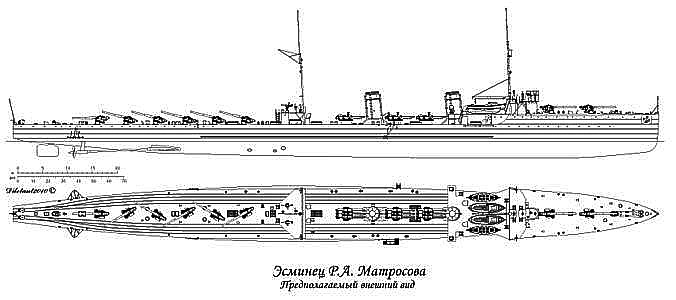
There is currently one Okhotnik class, seen above, as an improved Gaidamak 500-tonner. However, a World of Warship nice 3D rendition backed by alleged blueprints, on which a drawing was derived (see above) seems to point out some sort of improved Novik with a very impressive artillery on the aft deck. Fact or fiction ? Wargaming products are not known for historical accuracy, at least when it came to filling missing blanks in “tiers”, the game’s playable ship lineages.
First off, the real 1905 ship was sunk by the first aerial torpedo in history and her career is quite interesting enough. This alleged “Okhotnik” was launched on WoW as a premium Tier V, 2100 tons and 130 m long armed with 130 mm guns. An official video of the Okhotnik was released in April 2017.
Needless to say there is no trace of her in the bible of warships, Conway’s, nor Jane’s and that should be enough to discount this fantasy, unless this paper ship is based on the 2500 ton class super-destroyer seen above. But in that case, it’s more likely to pack a conventional artillery and TT arrangement.
The rendition is historically interesting, with but with two major flaws. First, a ship that size and with that much power showing only two funnels is way off the grid. Four funnels as previous Novik would have been more likely to avoid correct boilers exhaust and draft. Second, so many heavy guns on the rear deck would have been quite uneasy to handle in heavy weather. Training to have all these guns firing at the optimal position without interfering with each other was likely to be a nightmare, lightyears from the capabilities of notoriously undisciplined “Red” crews.
However, seeing Leitnant Ilin class (1915) rear deck artillery arrangement, it’s not difficult to see where this inspiration came from. Just as a reminder, firing at one meter or so of the next gun’s breechblock is a very bad idea. The fumes, noise, concussion are enough to have men sick, burnt, and out of action after the first blast… A safe distance should be kept. On Ilin, this could work if the guns are not centerline but on each side of the ship, to some extent. But for centerline guns, a gap of at least five meters is required for minimal safety, more if the gun is of larger caliber. So in the end this “okhotnik” remains in the video game fantasy world.
Read More
https://www.worldnavalships.com/russian_destroyers.htm
warhistoryonline.com – russian-destroyer-that-sank
On fr.naval-encyclopedia.com
naval-history.net Russian Navy 1914-1918 organization
Russian WWI torpedo ships on navypedia.org
Wiki List_of_destroyers_of_the_Imperial_Russian_Navy


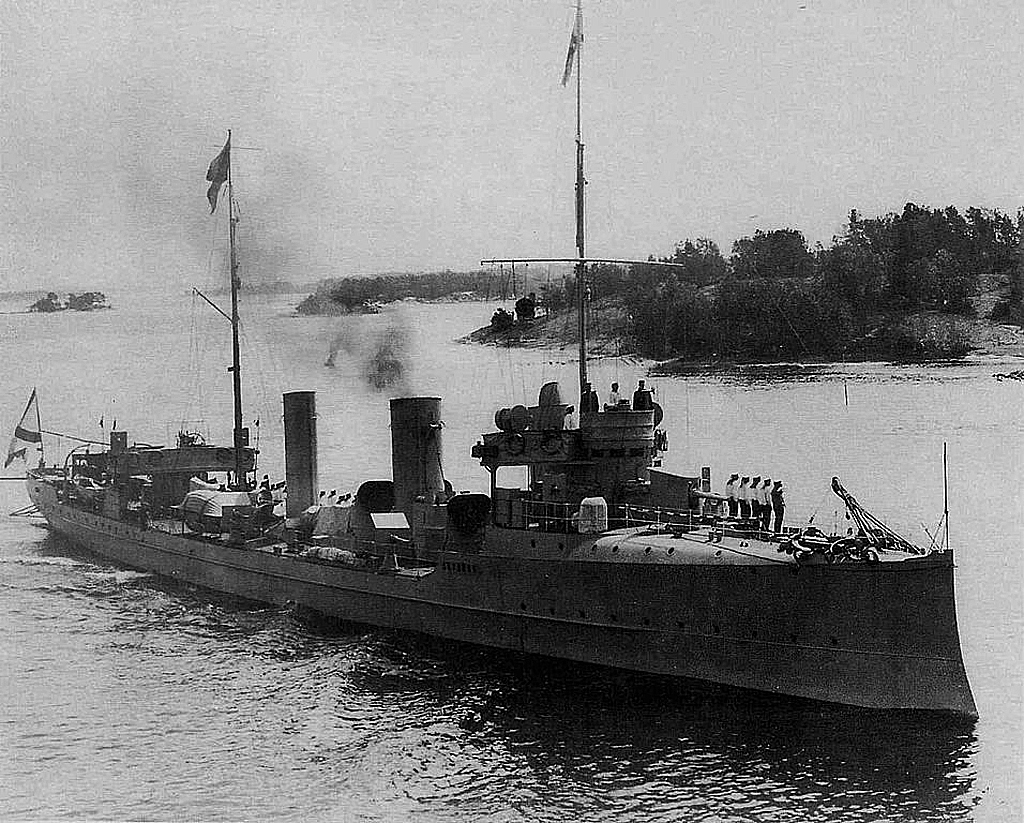
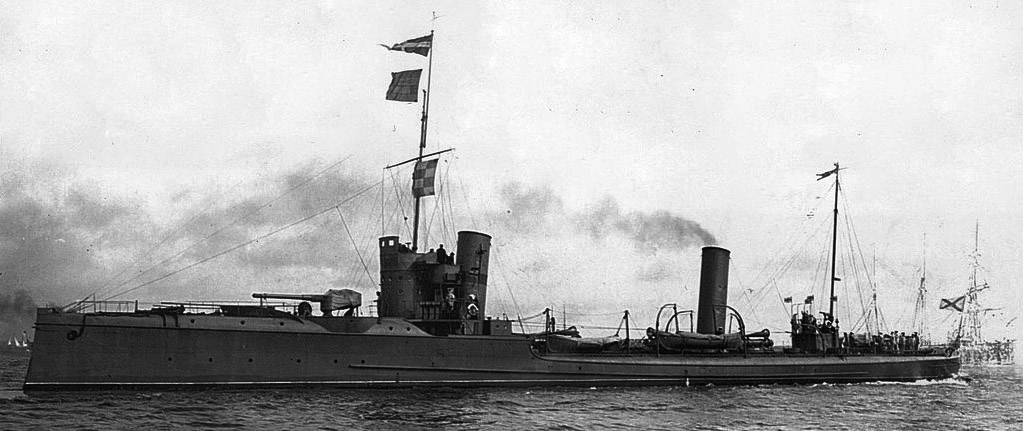

 Latest Facebook Entry -
Latest Facebook Entry -  X(Tweeter) Naval Encyclopedia's deck archive
X(Tweeter) Naval Encyclopedia's deck archive Instagram (@navalencyc)
Instagram (@navalencyc)





 French Navy
French Navy Royal Navy
Royal Navy Russian Navy
Russian Navy Armada Espanola
Armada Espanola Austrian Navy
Austrian Navy K.u.K. Kriegsmarine
K.u.K. Kriegsmarine Dansk Marine
Dansk Marine Nautiko Hellenon
Nautiko Hellenon Koninklije Marine 1870
Koninklije Marine 1870 Marinha do Brasil
Marinha do Brasil Osmanlı Donanması
Osmanlı Donanması Marina Do Peru
Marina Do Peru Marinha do Portugal
Marinha do Portugal Regia Marina 1870
Regia Marina 1870 Nihhon Kaigun 1870
Nihhon Kaigun 1870 Preußische Marine 1870
Preußische Marine 1870 Russkiy Flot 1870
Russkiy Flot 1870 Svenska marinen
Svenska marinen Søværnet
Søværnet Union Navy
Union Navy Confederate Navy
Confederate Navy Armada de Argentina
Armada de Argentina Imperial Chinese Navy
Imperial Chinese Navy Marinha do Portugal
Marinha do Portugal Mexico
Mexico Kaiserliche Marine
Kaiserliche Marine 1898 US Navy
1898 US Navy Sovietskiy Flot
Sovietskiy Flot Royal Canadian Navy
Royal Canadian Navy Royal Australian Navy
Royal Australian Navy RNZN Fleet
RNZN Fleet Chinese Navy 1937
Chinese Navy 1937 Kriegsmarine
Kriegsmarine Chilean Navy
Chilean Navy Danish Navy
Danish Navy Finnish Navy
Finnish Navy Hellenic Navy
Hellenic Navy Polish Navy
Polish Navy Romanian Navy
Romanian Navy Turkish Navy
Turkish Navy Royal Yugoslav Navy
Royal Yugoslav Navy Royal Thai Navy
Royal Thai Navy Minor Navies
Minor Navies Albania
Albania Austria
Austria Belgium
Belgium Columbia
Columbia Costa Rica
Costa Rica Cuba
Cuba Czechoslovakia
Czechoslovakia Dominican Republic
Dominican Republic Haiti
Haiti Hungary
Hungary Honduras
Honduras Estonia
Estonia Iceland
Iceland Eire
Eire Equador
Equador Iran
Iran Iraq
Iraq Latvia
Latvia Liberia
Liberia Lithuania
Lithuania Mandchukuo
Mandchukuo Morocco
Morocco Nicaragua
Nicaragua Persia
Persia San Salvador
San Salvador Sarawak
Sarawak Uruguay
Uruguay Venezuela
Venezuela Zanzibar
Zanzibar Warsaw Pact Navies
Warsaw Pact Navies Bulgaria
Bulgaria Hungary
Hungary

 Bundesmarine
Bundesmarine Dutch Navy
Dutch Navy Hellenic Navy
Hellenic Navy Marina Militare
Marina Militare Yugoslav Navy
Yugoslav Navy Chinese Navy
Chinese Navy Indian Navy
Indian Navy Indonesian Navy
Indonesian Navy JMSDF
JMSDF North Korean Navy
North Korean Navy Pakistani Navy
Pakistani Navy Philippines Navy
Philippines Navy ROKN
ROKN Rep. of Singapore Navy
Rep. of Singapore Navy Taiwanese Navy
Taiwanese Navy IDF Navy
IDF Navy Saudi Navy
Saudi Navy Royal New Zealand Navy
Royal New Zealand Navy Egyptian Navy
Egyptian Navy South African Navy
South African Navy






























 Ukrainian Navy
Ukrainian Navy dbodesign
dbodesign